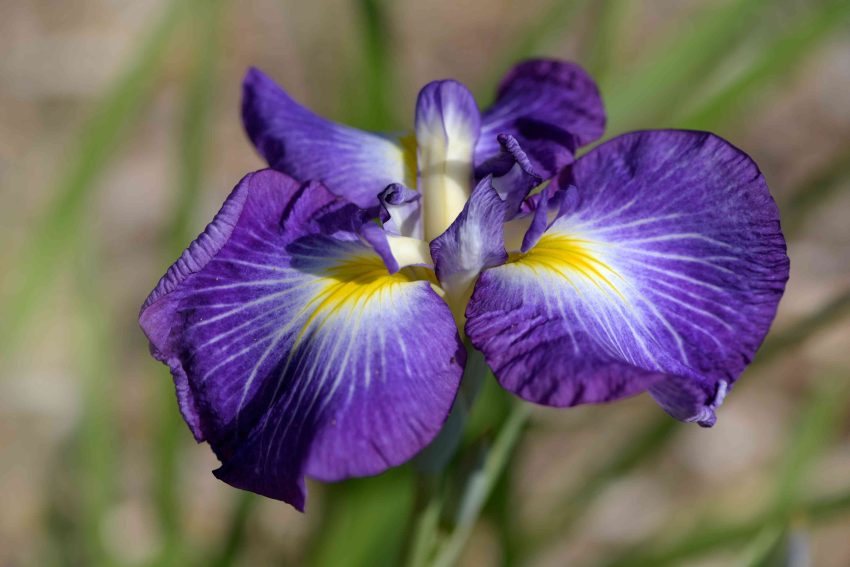magiccarouselsundays.com – The Japanese Iris (Iris ensata) is a stunning perennial flower that is admired for its large, intricate blooms and graceful appearance. Known for its vibrant colors and striking patterns, this flower is a popular choice for water gardens, ponds, and moist garden beds. With its ability to thrive in wet conditions and its timeless beauty, the Japanese Iris is a favorite among gardeners looking to add elegance and color to their landscapes.
Appearance and Characteristics
The Japanese Iris is best known for its large, showy flowers, which typically measure 5 to 6 inches across. The blooms come in a wide range of colors, including shades of purple, blue, pink, white, and even bi-color variations. The petals of the Japanese Iris are broad and ruffled, often with distinct veining or markings, giving them a delicate yet intricate appearance. These flowers appear in early to mid-summer, lasting for several weeks and creating a dramatic display of color.
The plant itself grows between 2 and 3 feet in height, with long, sword-like leaves that form a dense clump at the base. The foliage is usually a deep green and adds a vertical element to the garden. The Japanese Iris’s elegant blooms sit above the foliage on tall, slender stems, creating a refined, upright growth habit that makes the flowers stand out.
Growing Conditions
Native to Japan, the Japanese Iris thrives in moist conditions, making it an excellent choice for water gardens, pond edges, or boggy areas of the garden. It prefers full sun but can tolerate light shade, particularly in hotter climates where some afternoon shade can help prevent scorching. Japanese Irises grow best in rich, slightly acidic soil that is consistently moist, making them ideal for planting along the edges of ponds or in areas where the soil remains wet.
While the Japanese Iris prefers to grow in waterlogged conditions, it is not an aquatic plant and does not require the water to be submerged. Instead, the roots should be in soil that is kept consistently moist. These irises can also be grown in well-watered garden beds as long as they have sufficient moisture.
Care and Maintenance
Japanese Irises are relatively easy to care for, but they do require specific conditions to thrive:
- Watering: Ensure the plant has consistently moist soil. For water garden settings, plant the irises in shallow water where the roots are kept wet but the plant itself is not submerged. In garden beds, water regularly to keep the soil consistently moist.
- Light: Japanese Irises prefer full sun for the best blooming results, although they can tolerate light shade, particularly in hotter regions.
- Fertilizing: Apply a balanced fertilizer in early spring as new growth begins. Avoid over-fertilizing, as this can encourage too much foliage growth at the expense of blooms.
- Pruning: Deadhead spent flowers to encourage continued blooming and maintain a neat appearance. After flowering, remove any faded or damaged foliage.
- Dividing: Every 2 to 3 years, divide the clumps of Japanese Irises to prevent overcrowding and promote healthy growth. Divide them in early spring or after flowering.
Attracting Pollinators
Japanese Irises are known to attract pollinators, including bees and butterflies. Their vibrant, intricate flowers offer an abundance of nectar, making them a valuable resource for these important insects. By planting Japanese Irises in your garden or water feature, you can help support local pollinator populations and contribute to the overall health of your garden’s ecosystem.
Japanese Irises in the Landscape
The Japanese Iris is a versatile and elegant plant that works beautifully in a variety of garden settings. It is particularly well-suited to water gardens, where its preference for moist conditions is easily met. When planted along the edges of ponds or streams, the Japanese Iris can add a graceful element to the landscape, as the flowers’ vibrant colors reflect off the water’s surface.
These irises also work well in garden beds that receive regular watering, such as those near fountains or in boggy areas. They can be used as focal points in mixed perennial borders or planted in groups to create a dramatic effect. Their tall, upright growth habit also makes them ideal for planting in the background of garden beds or along pathways, where their striking flowers can be admired up close.
Conclusion
The Japanese Iris is a beautiful and versatile perennial that brings a touch of elegance to any garden. With its large, intricate flowers, graceful foliage, and preference for moist conditions, it’s a perfect choice for water gardens, ponds, and garden beds. Whether used in a water feature, as part of a mixed perennial border, or as a standalone specimen, the Japanese Iris adds a refined and timeless beauty to the landscape. Its ability to attract pollinators further enhances its value, making it a plant that is not only aesthetically pleasing but also ecologically beneficial.

